Images of Hell and Art People Cooking in Pot
Illustration from Carsten Egeberg Borchgrevink's Das Festland am Südpol (1905)
It'due south a dog-eat-dog world downward at that place at the South Pole
The morning of January iv, 1909 establish Ernest Shackleton and his crew on the vast and desolate Ross Ice Shelf. Hell-bent on reaching the South Pole, they had faced some tough going. Fierce winds buffeted them. An ice chasm had swallowed their sole remaining pony, and the lost animal'due south burden thus became theirs. Each coiffure fellow member pulled a sledge loaded with some 70 pounds of supplies, straining muscles left cramped by nights spent in ice-rimed sleeping numberless.
Yet frostbite and charley horses pained them less than the hunger they felt. Their rations almost exhausted, they knew starvation loomed. "The end is in sight," Shackleton wrote that bleak January morning time. "Brusk food and a blizzard air current from the south." In four months they had enjoyed only one full repast. They subsisted on crushed biscuits, rancid pony meat, pemmican (meat mixed with vegetable matter and fat), the occasional seal or penguin — and these in portions barely able to sustain them. How long they might continue to sustain them, no one could say. In much the same state a month later, Shackleton would write, "Feel starving for nutrient…. Talk of it all twenty-four hour period."
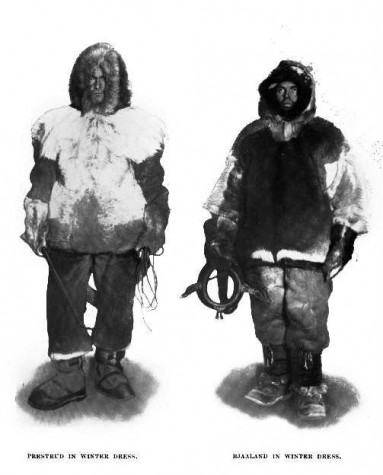
Photographs from Roald Amundsen'southward The South Pole: An Account of the Norwegian Antarctic Expedition in the 'Fram', 1910-1912 (1913)
If ever a identify existed where it was better that food exist had than talked nearly, it is Antarctica. The continent boasts no forests, pastures, prairies, or rivers. Its frigid wastes cover an area larger than Republic of india and China combined. It is quite literally like no other place on earth. To find its nearest equivalent, you have to look to outer space — to Europa, the icy moon that orbits Jupiter, to be exact.
For a place and then utterly blank, Antarctica has made for many inked pages. Each twelvemonth sees books published on any number of Antarctic-related topics. 2 recent releases, Jason C. Anthony'sHoosh: Roast Penguin, Scurvy Twenty-four hours, and Other Stories of Antarctic Cuisine,
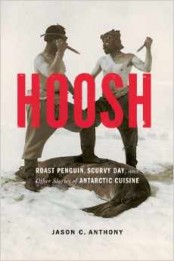
and Wendy Trusler and Carol Devine'southwardThe Antarctic Book of Cooking and Cleaning, take up the subject area of hospitality in an inhospitable land, which owed as much to luck as to invention or proper planning. What comprises "Antarctic culinary history," Anthony writes, is "a mere century of stories of isolated, insulated people eating either prepackaged trek nutrient or butchered sea life."
It helped if some of these isolated, insulated people knew their mode around the kitchen. "The cook, however good or bad, is an artist whose simple vocation is to make others lives happier," observed chef Raymond Oliver. More than wizard than artist, a cook with an Antarctic expedition ranked as one of its about important members. His kitchen little more than a Primus stove, his ingredients either canned or scrounged, he conjured nourishing dishes equally if from the gelid air.
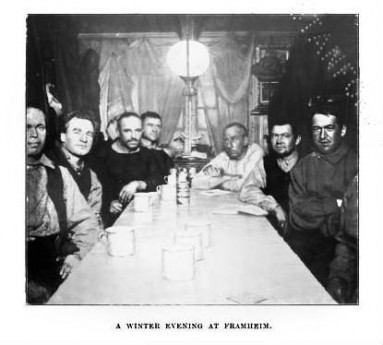
The annals of Antarctic exploration abound with colorful depictions of beloved cooks. Rozo, the popular cook of Jean-Baptiste Charcot's 1903 French Antarctic Trek, offers a fine example. An air of mystery surrounded him. No one knew his true name or historic period considering he fraternized fiddling, preferring the company of Toby, the trek'south pet pig, to that of his fellow crew. He read widely and had a quick wit. Yet he hated to wear socks and would instead pad almost in onetime business firm shoes that he slipped over his blank feet. The moist croissants and sweet patisseries Rozo whipped up, nevertheless, more than than made up for any eccentricities. Indeed, his quirks and culinary skills combined to make him seem larger than life. "He was like someone from a novel," Charcot recalled, "and we near expected him to arrive one day and announce … that he knew a very easy style to the Pole itself."
But Rozo knew no mode, easy or hard, and the French trek penetrated no further than the Antarctic coast. The Norwegians were the offset to attain the S Pole in 1911. Led by Roald Amundsen, the Norwegian expedition featured its own treasured cook, a human being past the name of Adolf Lindstrøm. From his tiny hut continuing at the foot of the Ross Ice Shelf issued savory seal stew and stacks of buckwheat pancakes slathered in cloudberries. Lindstrøm took intendance to cook in such a way every bit to preserve equally much of the food'southward nutritional value equally possible. "A better man has never set foot within the polar regions," wrote Amundsen in praise of Lindstrøm. "He has done Norwegian polar expeditions greater and more valuable service than anyone else."
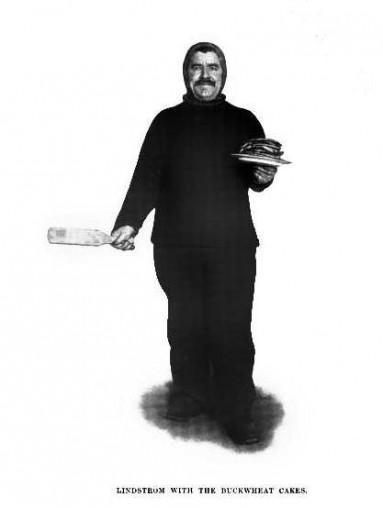
Whatsoever cook worth his common salt knew how to transform the Antarctic'southward seemingly unappetizing wildlife into palatable fare. A dish of penguin prepared for the American explorer Frederick Cook tasted to him like "a piece of beef, odoriferous cod fish, and a canvas-backed duck roasted together in a pot, with blood and cod-liver oil for sauce." The Germans fared a scrap better. Karl Klück, melt for a 1901 expedition, reliably whipped up seal sauerbraten tasty enough to please any bürgermeister.
T.C. Clissold, cook for Robert Falcon Scott'due south 1910 British expedition, brought seal meat within kissing distance of haute cuisine. His seal rissoles sent the coiffure into raptures, and his seal galantine, with its force-meat stuffing and cold aspic glaze, left a sheen of gourmandise on the stiffest upper lip. "It is the commencement time I take tasted seal without being aware of its detail flavour," Scott wrote of tasting Clissold'southward handiwork.
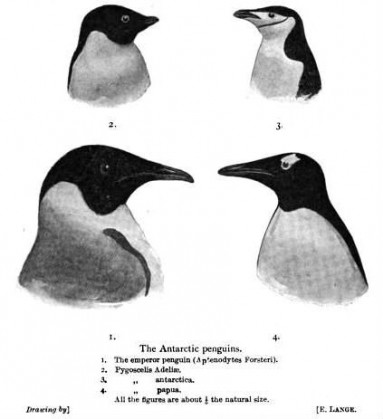
Analogy from Otto Nordenskjöld'due south Antarctica: or, Two Years Amongst the Water ice of the S Pole (1905)
Of class, such brave dishes as those past Klück and Clissold represented Antarctic cuisine prepared under the best circumstances. One time the explorers took to their sleds, rissoles and sauerbraten became mere memories and austerity the dominion. They dined on whatever they managed to fodder from snowfall drifts or whatever provisions they brought along — their ponies and sled dogs included. The practice of eating pack animals, while seemingly cruel, was driven past a compelling logic: As the explorers consumed food and fuel, their sled loads lightened. Lighter sleds needed fewer dogs to pull them. Dogs thus made redundant became food for their fellows and the explorers. Amundsen slaughtered 24 salubrious dogs during a unmarried expedition. Doing so filled him with a sublime awe. "Great masses of beautiful fresh, ruddy meat," he wrote of the butchering, "with quantities of the most tempting fat, lay spread over the snow," calling to mind "memories of dishes on which the cutlets were elegantly arranged side by side, with paper frills on the bones, and a corking pile ofpetit pois in the centre."
When non eating their sled dogs and ponies, explorers ate hoosh. Otherwise known as "meat stew of the ravenous," Anthony writes, "hoosh is a porridge or stew of pemmican and water, frequently thickened with crushed biscuit." But anything, actually, might get tossed in the pot — seaweed to bulk it upwards or, if Fortune smiled, brains, livers, and kidneys of diverse Antarctic animals to boost its nutritional value. Anthony notes one rather exotic hoosh made of penguin flipper and rope treated with Stockholm tar.
Nonetheless bizarre or nasty its ingredients, hoosh enjoyed indelible appeal. Hungry explorers coveted information technology, and anyone who cheated them of their share had hell to pay. Expedition leaders consequently devised various stratagems to divvy the stuff. Scott, for example, resorted to playing "Shut-Eye," in which he would assign, without looking, mugs of hoosh to men who themselves had their backs turned.
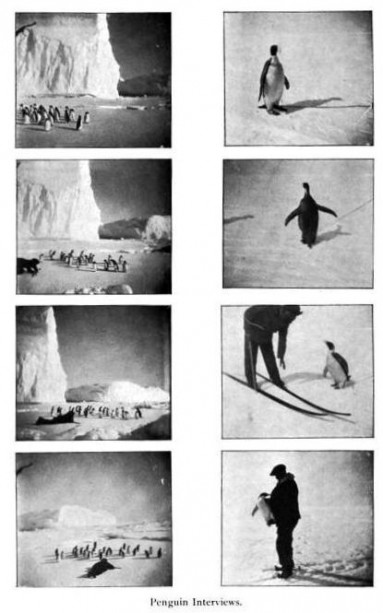
Photograph from Frederick Albert Cook's Through the First Antarctic Night, 1898-1899 (1900)
Hoosh was prized and so highly because in nigh cases other options were worse. A diet unsupplemented by Antarctic bushmeat led to scurvy. The fate of the 1897 BelgianBelgica expedition attests to the ravages of this disease built-in of malnutrition. That ship's coiffure planned their polar foray with the expectation that earlier winter's onset they would head northward. They failed to beat out a brisk enough retreat, still, and found themselves locked in ice. Fresh food nowhere available, the men of theBelgica improvised, Anthony quotes one of the crew members equally saying, with "laboratory mixes in cans … hashes nether various catchy names … sausage stuffs in deceptive forms, meat and fishballs said to incorporate cream, mysterious soups, and all the latest inventions in condensed foods." None of these marvels of modern food processing independent enough ascorbic acrid to foreclose scurvy. Ii sailors went insane, the residual endured bleeding gums, blackened legs, stubborn wounds, and other unpleasant symptoms. Fifty-fifty the send's cat died.
Worse than scurvy was starvation, equally Shackleton's men discovered that cruel wintertime of 1909. "The group's sparse hooshes … could not compensate for the thousands of calories burned daily while hauling their heavy sledge," Anthony writes. A human pulling a sledge burned more calories a mean solar day than does one pedaling a bicycle in the Tour de France. And though the explorers organized their treks forth "an umbilical cord of depots," much could go wrong. The worst period of the expedition saw them reduced to four "miserably sparse" biscuits per twenty-four hour period.
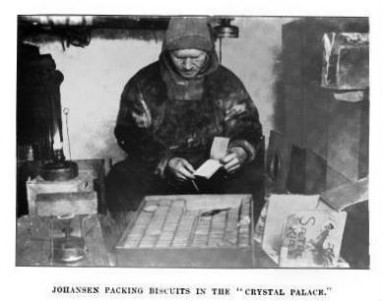
Photo from Roald Amundsen's The S Pole: An Account of the Norwegian Antarctic Expedition in the 'Fram', 1910-1912 (1913)
When hunger pinched, Shackleton and his men joked about food. When hunger gnawed, food became no laughing matter. It became, rather, stuff to fill the head if not the abdomen. "On the march," Anthony continues, "they described previous feasts and fantasized near the banquets they would lay out for each other if they reached culture." One such fantasy involved vi sumptuous meals served in a single day.
When Shackleton's men didn't dream of food, they read about it. More treasured than bibles were penny cookbooks they brought forth on the trip. They studied the recipes therein, annotated them, and argued over which ingredients worked best and which fashion of preparation produced the tastiest outcome.
Equally sails ceded to steam, polar expeditions became much less of a take a chance. And, every bit the risks decreased, then too did the savor of the adventure. The history of Antarctic food "loses some of its drama subsequently the heroic age," Anthony admits. "[T]oo wealthy and too well-informed," mid 20th-century explorers traveled on self-propelled ships and sleds and ate nutrient-dumbo, industrially produced rations. Yet Wendy Trusler and Carol Devine would likely dispute this conclusion. The many anecdotes and accounts they include inThe Antarctic Volume of Cooking and Cleaning suggest that, in terms of diet or anything else, modern-day polar forays aren't necessarily duller than those of yesteryear.
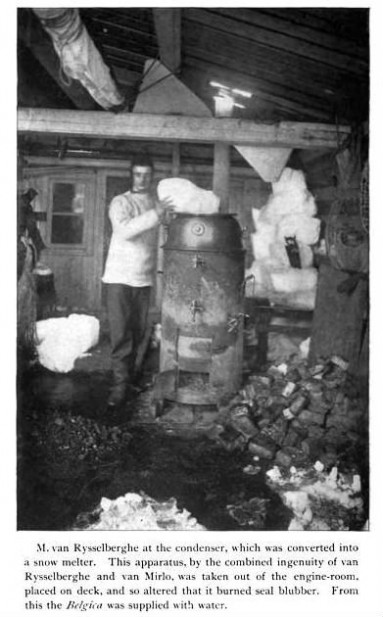
Photograph from Frederick Albert Cook'southward Through the First Antarctic Night, 1898-1899 (1900)
In 1996, Canadians Trusler and Devine journeyed with several groups of volunteers to a small isle 120 kilometers off the Antarctic declension to cleanse information technology of 28 years' worth of accumulated garbage. Hence the book's championship. The book itself may be variously draw as a cookbook, a diary, a photo-journal, and tribute to those early explorers who survived on penguin and dog-manus stew.
Devine tells an inspiring story. "I wanted to do something previously untried," she writes of organizing the expedition. Together with a company that "took adventurers to the Antarctic," she established the Volunteer International Environment Work foundation and lead a trip to clean out debris and scientific equipment at the Henryk Arctowski station in the Southward Shetland Islands. Not long subsequently, she gear up a second expedition, Project Antarctica Ii. Larger than the beginning, this project was plagued by provisioning fiascoes, cultural misunderstandings, logistical difficulties, and rotten atmospheric condition. "We knew what we'd confront couldn't be anything as serious or tough equally the challenges endured by old-school Antarctic explorers," Devine writes, "but despite understanding scurvy and having the benefit of modern communication, applied science and flights to the Antarctic, the variables were many."
I constant among the variables was Wendy Trusler, whom Devine hired to be the trek's cook. As ingenious and stalwart equally her Antarctic forebears, Trusler recounts the joys and hardships of kitchen direction at the end of the earth. "Pizza night Custard with rum sauce and candied almonds Cooking hell," reads a December 23, 1995 entry from Trusler'due south diary reproduced in the book. "Will I get organized?" The reply was incomparably "yes," because two days later she pulled off a dinner of turkey with dressing, roast daikon radish, yams and onions, cranberry sauce, corn on the cob, asparagus with dill butter, greenish salad with croutons, and, what must have been a divine care for in the polar wastes, a Bavarian apple torte. "The best Christmas ever," she judged the occasion. Given what she was upwardly against, the reader is inclined to agree.
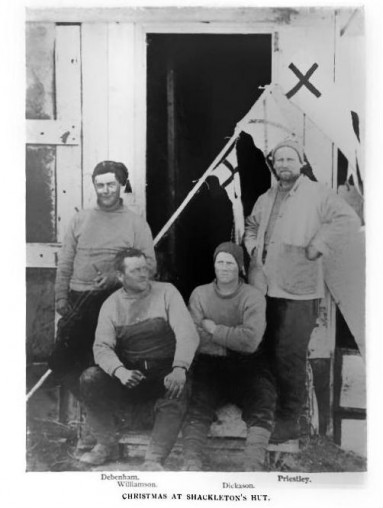
Photo from Raymond Edward Priestley and Robert Falcon Scott's Antarctic Adventure: Scott's Northern Political party (1915)
Her skills honed in the "bush camps across Canada," Trusler subscribes to the school of "pitch-and-toss cookery," in which deficient ingredients forcefulness instinct and imagination to commingle in a sort of culinary gestalt. She takes the aforementioned approach to the recipes inThe Antarctic Book of Cooking and Cleaning. "Yous'll discover these recipes are written in an idiosyncratic style," she writes, "but I hope they'll encourage y'all to gustation, wait for visual clues and develop a existent feel for whatever yous are preparing."
Trusler's recipes are a charming mix of her own idiosyncratic concoctions and recipes cherished and shared past her fellow activists. There's "Saying's Moonshine," a stiff liquor of yeast, saccharide, and water. Trusler got the recipe from a Russian glaciologist who warned that "it is … absolutely disgusting stuff, which may be consumed at an Antarctic station when nothing else is available." Proverb too supplied an equally dubious recipe for a mixture of kelp, onion, garlic, and mayonnaise he chosen body of water cabbage salad. Trusler juxtaposes these concoctions with more than appetizing offerings such as mulled wine, rosemary maple borscht, rosemary-encrusted lamb ribs, custard with fruit compote, cranberry fool, and cheese fondue. (This last dish moved one volunteer to opine, "If Wendy had been along, Scott would have made it.") Containing some the most tempting expedition cuisine I've seen,The Antarctic Book of Cooking and Cleaning is a must-buy for eco-witting foodies.
Devine writes that Trusler's cooking "reflected doing the all-time with what you lot take." Her sentiment chimes with the notion, commencement advanced by French theorist Roland Barthes, that, more than anything else, food "constitutes an information." Independent in that information is "an unabridged 'world,'" by which he means "social environment." The biggest pot of hoosh couldn't match a tin can of peaches when information technology came to comfort and reassurance. Shackleton understood this. He famously squirreled away jam, chocolate, anchovies, and other treats to give his men whenever he sensed their spirits sink. When Trusler radioed for brownish saccharide and chocolate fries from one of her supply ships, surely she wanted to recreate a social environment homely and familiar. "[I]t'due south funny what you tin't alive without," she observes.
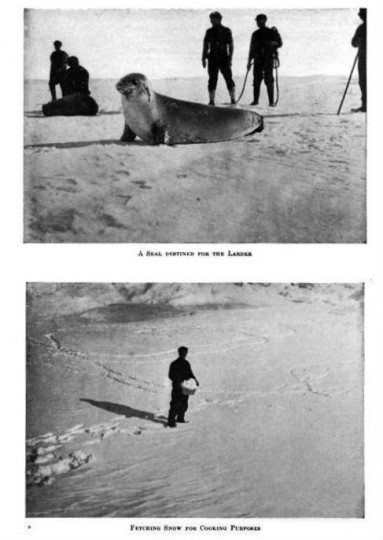
Photograph from Sir Ernest Henry Shackleton's The Centre of the Antarctic (1914)
Both Anthony'sHoosh and Devine and Trusler'southThe Antarctic Book of Cooking and Cleaning illustrate the extent to which nutrient nourishes the spirit likewise every bit the body. Anthony's freewheeling account is sometimes difficult to follow. Merely the chapters detailing the trials and tribulations of the cooks of the heroic historic period of polar exploration are engaging, and Anthony has collected an impressive amount of information on the topic. This alone makes his volume essential for anyone interested in exploration cuisine.The Antarctic Book of Cooking and Cleaning is an enjoyable glimpse into a noble endeavor undertaken in the closing years of the last century, when at that place all the same were places that seemed cut off from the rest of the world.
Today the Antarctic stations take Internet access, a development that has undoubtedly fabricated any sense of isolation less than utter. And climate change has spurred a new spirit of exploration, one more dubious than heroic. Various governments and private interests take begun to consider plundering these white wastes for the gilt, uranium, natural gas, and oil that lies deep beneath them. If that happens, Antarctica, remote and vast equally it is, volition surely go to the dogs, leaving none fifty-fifty to eat.
Source: https://thenewinquiry.com/the-art-of-antarctic-cooking/
0 Response to "Images of Hell and Art People Cooking in Pot"
Post a Comment